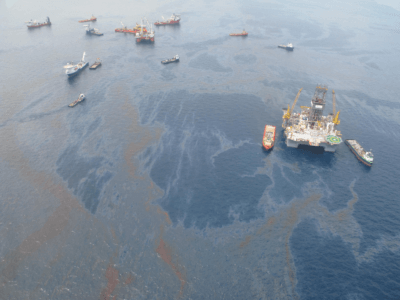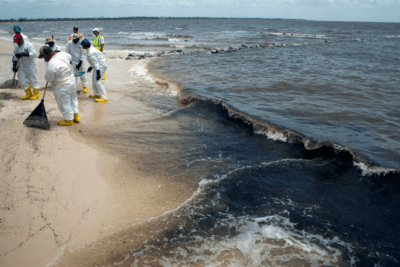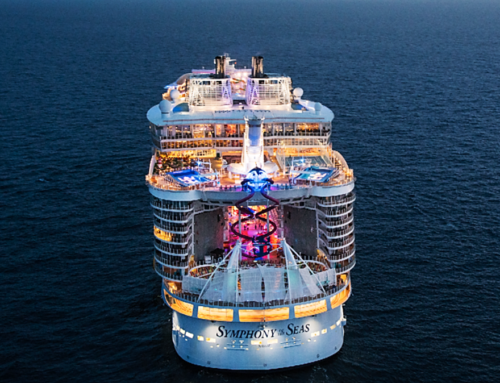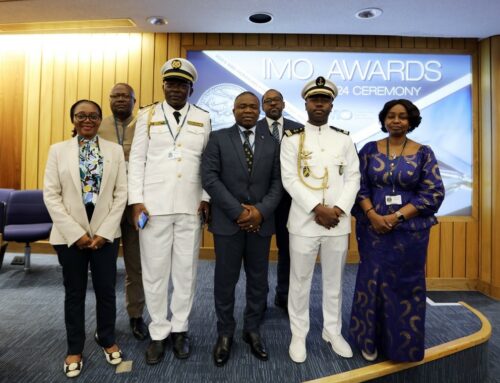The Deepwater Horizon Spill: 13 Years Later
 On April 20, 2010, a massive explosion rocked the Deepwater Horizon, an offshore oil rig drilling in the Macondo Prospect, a deepwater oil reservoir in the Gulf of Mexico. The blast killed 11 workers and injured 17 others, and triggered the largest maritime oil spill in history. For 87 days, oil gushed from the ruptured wellhead, spilling an estimated 210 million gallons of crude oil into the Gulf’s waters, affecting the coasts of Texas, Louisiana, Mississippi, Alabama, and Florida.
On April 20, 2010, a massive explosion rocked the Deepwater Horizon, an offshore oil rig drilling in the Macondo Prospect, a deepwater oil reservoir in the Gulf of Mexico. The blast killed 11 workers and injured 17 others, and triggered the largest maritime oil spill in history. For 87 days, oil gushed from the ruptured wellhead, spilling an estimated 210 million gallons of crude oil into the Gulf’s waters, affecting the coasts of Texas, Louisiana, Mississippi, Alabama, and Florida.
In addition to the seamen killed or injured aboard the rig, the spill had devastating impacts on the environment, wildlife, and human health. Oil slicks covered nearly 60,000 square miles of ocean surface, while tar balls washed up along 4,500 miles of shoreline. Thousands of birds, mammals, fish, and other marine life were killed or harmed by the oil and the dispersants used to break it up. The spill also disrupted the livelihoods of millions of people who depend on the Gulf for fishing, tourism, and other industries.
Thirteen years later, how has the Gulf recovered from the spill? What have we learned from the disaster? And what are the risks of another spill happening in the future?
Recovery Efforts
BP, the company that leased the Deepwater Horizon rig and operated the Macondo well, agreed to pay more than $65 billion in fines, penalties, settlements, and cleanup costs for the spill. The company also set up a $20 billion trust fund to compensate individuals and businesses affected by the spill. BP also funded several research programs to study the impacts of the spill on the Gulf ecosystem and to improve oil spill response technologies.
The federal government also took steps to improve offshore drilling safety and oversight. In 2010, President Barack Obama established a commission to investigate the causes of the spill and make recommendations for preventing future disasters. The commission found that the spill was caused by a series of failures– in well design, cementing, maintenance, testing, and emergency response. The commission also criticized BP, its contractors, and federal regulators for a “culture of complacency” that prioritized profits over safety.
 Based on the commission’s findings, the Department of the Interior restructured its offshore drilling agency and issued new rules for well design, blowout preventers, drilling safety plans, inspections, and enforcement. The department also created a new bureau to oversee environmental reviews and permitting for offshore projects.
Based on the commission’s findings, the Department of the Interior restructured its offshore drilling agency and issued new rules for well design, blowout preventers, drilling safety plans, inspections, and enforcement. The department also created a new bureau to oversee environmental reviews and permitting for offshore projects.
The oil industry also made some changes to improve its safety standards and practices. In 2010, several major oil companies formed a consortium called the Marine Well Containment Company (MWCC), which developed a system to quickly cap and contain a blown-out well in deep water. The MWCC also maintains a fleet of vessels and equipment that can be deployed in case of an emergency. The industry also adopted new guidelines for well design, testing, cementing, and monitoring.
Lingering Impact
Despite these efforts, scientists say that there is still much more to learn about the long-term effects of the spill on the Gulf ecosystem and human health. Many studies have found evidence of lasting damage to marine life, habitats, and food webs. For example:
- A 2017 study found that dolphins in Barataria Bay, Louisiana, one of the most heavily oiled areas during the spill, had lower survival rates and reproductive success than dolphins in other parts of the Gulf.
- A 2018 study found that coral reefs in the deep sea near the Macondo well suffered extensive injury and mortality from exposure to oil and dispersants.
- A 2019 study found that fish exposed to oil from the spill had impaired heart function and reduced swimming performance.
- A 2020 study found that oil from the spill altered the composition and function of microbial communities in sediments across a large area of the seafloor.
Scientists also warn that some of the impacts of the spill may not be apparent for years or decades. For instance, oil may accumulate in sediments or tissues over time and cause chronic or delayed effects on organisms. Oil also may interact with other stressors such as climate change, hypoxia (low oxygen), or encourage harmful invasive species to flourish, exacerbating their impacts on ecosystems.
Moreover, scientists say that there is still a lack of data on some aspects of the spill’s impacts. For example:
- Limited information on how oil affected deep-sea ecosystems beyond coral reefs.
- Limited information on how oil affected endangered or threatened species such as sea turtles or sperm whales.
- Limited information on how oil affected human health among cleanup workers or coastal residents.
Challenges Remaining
While some progress has been made in reducing some risks associated with offshore drilling in the Gulf of Mexico since the Deepwater Horizon spill, some challenges remain. For example:
- The Gulf of Mexico is still a major source of oil and gas production for the U.S., and the demand for offshore drilling is expected to increase in the coming years. According to the Energy Information Administration, the Gulf of Mexico accounted for 17% of U.S. crude oil production and 5% of natural gas production in 2020, and these shares are projected to rise to 19% and 7%, respectively, by 2025.
- The offshore drilling industry is moving into deeper and more remote areas of the Gulf, where the technical and environmental challenges are greater. The average water depth of new wells drilled in the Gulf increased from 1,000 feet in 2000 to 4,000 feet in 2019, and some wells are drilled in depths exceeding 10,000 feet. These depths pose higher pressures, temperatures, and uncertainties for well design and operation.
- The regulatory environment for offshore drilling has become less stringent under the Trump administration, which rolled back some of the safety rules and environmental reviews implemented after the Deepwater Horizon spill. For instance, in 2019, the Department of the Interior revised the well control rule, which sets standards for blowout preventers and other equipment and procedures to prevent or stop a spill. The revision eliminated or weakened some of the requirements, such as third-party certification, real-time monitoring, and pressure testing.
- The scientific understanding of the Gulf ecosystem and its resilience to oil spills is still incomplete and evolving. There are still gaps in baseline data, monitoring programs, and modeling tools that are needed to assess the impacts and recovery of ecosystems after a spill. There are also uncertainties about how climate change will affect the Gulf’s physical, chemical, and biological processes and how they will interact with oil spills.
The Deepwater Horizon spill was a wake-up call for the U.S. to rethink its reliance on offshore oil and gas and to improve its preparedness and response capabilities for future spills. Thirteen years later, some lessons have been learned and some improvements have been made, but some risks remain or have increased. As the U.S. transitions to a cleaner and more sustainable energy future, it is crucial to protect the Gulf of Mexico from another disaster that could jeopardize its ecological integrity and economic vitality.
We at the Herd Law Firm are proud to fight for seamen, maritime workers and passengers in all types of personal injury claims, and never waver in our commitment to help these maritime workers and their families when they are injured.
Sources:
- 13 Years Later, Oil Drilling in Gulf Safer, But Concerns Persist, Study Says
- 13 Years Later: The Deepwater Horizon Spill
- The Deepwater Horizon spill started 10 years ago. Its effects are still playing out
- Deepwater Horizon Oil Spill: 13 Years Later
7/24/2023
Image Source: NOAA







